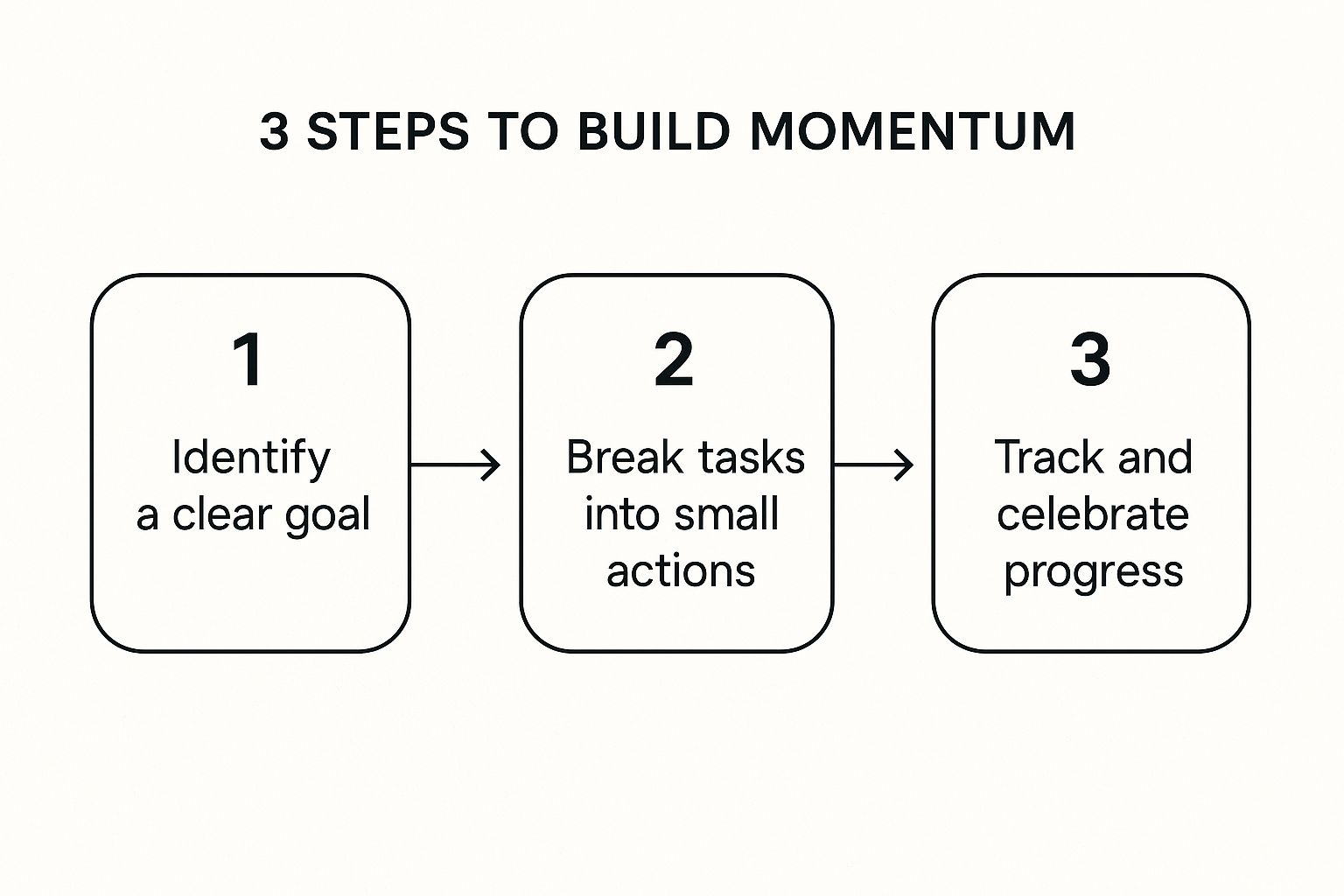How to Build Momentum and Keep Progress Going
Learn how to build momentum with our founder-focused guide. Discover practical, science-backed strategies to move from stagnation to unstoppable progress.
That feeling of being completely stuck is a classic founder roadblock. We've all been there. But building unstoppable momentum is simpler than you think. The key is a three-part framework: Start Small, Build Consistency, and Scale Intelligently. This isn't just motivational fluff; it’s a repeatable, science-backed system for turning tiny actions into a powerful, self-sustaining force.
The Real Physics of Professional Momentum

Momentum isn’t just a buzzword. It's a real, tangible force you can build and control. For founders who live and die by predictable outcomes, the first step is to stop treating it as a vague feeling and start treating it like a system.
Think of it like a heavy flywheel. That first push is the absolute hardest. But each subsequent push gets a little easier, building on the last, until the wheel is spinning with incredible, self-sustaining force.
This isn't just a metaphor; it's grounded in behavioral science. When you achieve small, consistent wins, your brain releases dopamine, creating a positive feedback loop. This neurological reward makes it psychologically easier to tackle the next task, reinforcing the habit of taking action. It literally rewires your brain to favor progress.
The Core Components of the Momentum Flywheel
The secret to building momentum isn't one giant, heroic leap. It's a series of small, connected, and deliberate actions. Your strategy should revolve around creating a cycle where progress fuels more progress.
To put this into action, we can break down the flywheel into its core components.
The table below outlines the "Momentum Flywheel," a system that turns abstract principles into concrete actions for busy founders.
The Momentum Flywheel Key Components
| Component | Principle | Founder-Focused Action |
|---|---|---|
| Initial Push | Overcome Inertia | Ship a tiny bug fix instead of waiting for a major feature. The goal is the smallest possible visible win. |
| Consistent Motion | Create Reliable Systems | Use a daily check-in or a simple "wins log" to make progress a non-negotiable part of your routine. Don't rely on willpower. |
| Strategic Acceleration | Apply Force Where It Counts | Once you have a rhythm, double down on the one activity that's generating 80% of the results. |
This isn't about just doing more. For a founder, this system in action looks like shipping a tiny bug fix instead of getting bogged down waiting for a major feature release. That one small, visible accomplishment creates the energy and psychological safety to tackle the next task, and then the next.
Soon enough, you’ve built a rhythm of progress that starts to feel unstoppable.
Momentum is the cumulative result of smart, small, and consistent actions. It's the polar opposite of waiting for a single, heroic effort to save the day. It’s about building a machine that produces results predictably.
By focusing on the physics of progress—small inputs leading to compounding outputs—you move beyond just being busy. You start building real, directed force toward the goals that actually matter. This approach transforms your work from a chaotic series of disjointed tasks into a cohesive engine for growth.
Overcoming Inertia with Minimum Viable Actions
The single biggest enemy of momentum isn't a lack of motivation—it’s the sheer size of the goal you're staring at.
A massive objective like "launch a new product feature" or "start a marketing campaign" feels so overwhelming it can trigger paralysis. We call this inertia, and it's the default state for any ambitious project. The secret to breaking through isn't to muster more willpower, but to radically shrink the first step.
This is where the Minimum Viable Action (MVA) comes in. An MVA is the smallest, most laughably simple task you can perform to get started. It’s a step so tiny that procrastinating on it feels more difficult than just doing it.
Deconstructing Goals into Micro-Tasks
Instead of wrestling with the entire marketing campaign, your MVA might be to simply "draft three potential headlines for the first email." You're not writing the email or building the list. You're just drafting three headlines. This takes less than 5 minutes, but it does something profound: it moves you from a state of zero to one.
This approach works by shifting your brain's focus from an intimidating outcome to a simple, achievable action.
-
Massive Goal: Launch a new product feature.
-
MVA: Create a single blank document and title it with the feature's name.
-
Massive Goal: Secure a new round of funding.
-
MVA: Open LinkedIn and identify one potential investor to research tomorrow.
Every time you complete one of these micro-tasks, your brain rewards you with a small hit of dopamine. This isn't just a feel-good platitude; it's a real neurological event that wires a powerful positive feedback loop. Each completed MVA makes the next small action feel a little easier, building a chain reaction of progress.
This image illustrates how that cycle works.

As you can see, momentum isn't born from one giant push. It’s a repeatable cycle: break down goals, take small actions, and let the tiny wins fuel the next step.
The goal isn't to finish the project today. The goal is to make a single, irreversible step forward. By focusing on the MVA, you're hijacking your brain's own reward system to work for you, not against you.
Making Progress Impossible to Avoid
This strategy is about making progress the path of least resistance. It’s less about brute-force discipline and more about smart psychological design.
Over time, these MVAs naturally link together. You find yourself completing larger chunks of work without ever feeling that initial, paralyzing dread. These tiny actions compound into significant achievements before you know it.
This process is fundamental to creating any kind of lasting change. For those who want to go deeper, understanding how to build good habits is the perfect next step, as it provides a framework for turning these initial actions into automatic behaviors.
For any busy founder, consistently applying the MVA principle is the most practical way to conquer inertia and make that crucial first push toward your goals.
Building Systems to Outlast Willpower

Heroic, one-off efforts feel great, but they don't sustain progress. Real momentum isn’t fueled by fleeting bursts of inspiration. It’s built on reliable systems that guarantee output, even on the days you feel completely drained.
Relying on willpower is like trying to run your company on a phone with 10% battery. It’s a finite resource that is guaranteed to deplete, usually right when you need it most. The solution is to stop trying to motivate yourself and start building a well-oiled machine for progress—shifting the focus from internal grit to external processes.
This is how you build momentum that lasts.
Automate Your Next Action
One of the most powerful systems you can create is one that makes starting ridiculously easy. This is the simple genius behind the Two-Minute Rule, a concept from behavioral science. The rule is simple: if a task takes less than two minutes, do it immediately.
This hack bypasses the mental debate that so often leads to procrastination. Instead of thinking about archiving an email, you just do it. This creates a cascade of small wins that build the energy you need for bigger, more demanding tasks.
- Instead of: "I really need to clean my desk."
- System: "If I see a piece of trash on my desk, I throw it away immediately."
This subtle shift removes friction and makes the behavior automatic. You’re no longer waiting to feel motivated to clean; you're just following a pre-defined rule.
Systems ensure you make progress when you don't feel like it. They are the guardrails that keep you moving forward when willpower and motivation take a day off.
For founders, this is about creating processes that trigger the next step without a conscious, energy-draining decision. And it goes beyond just you. Learning how to improve workflow efficiency is critical for building systems that create consistent momentum across your entire team.
Design Your Environment for Success
Your environment is an invisible force that powerfully shapes your behavior. A systems-first approach means intentionally designing your physical and digital spaces to make good habits the easy choice and bad habits difficult.
For example, if a founder wants to read more industry reports, they might place a specific report on their desk the night before. This small act eliminates the morning friction of deciding what to read, making the desired action the path of least resistance.
Implement If-Then Plans for Distractions
Distractions are guaranteed momentum-killers. A brilliant system for neutralizing them is the if-then plan, known in psychology as an implementation intention. It works by pre-deciding exactly how you'll respond to a specific trigger.
Here’s what it looks like in practice:
- IF I get a non-urgent Slack message while I'm in deep work, THEN I will add it to a "reply later" list and check it in an hour.
- IF I feel the urge to mindlessly scroll social media, THEN I will stand up and stretch for one minute instead.
Behavioral psychology studies have shown this simple technique can double or even triple your chances of sticking to a goal. It automates your response to distractions, preserving your precious mental energy for the work that actually matters.
Of course, these external systems are only half the battle. Your internal drive is the other part of the equation, and understanding the nuances of staying motivated can supercharge these systems for truly unstoppable achievement.
This isn't just about your personal to-do list.
The same principles that create personal momentum can become a powerful strategic engine for your entire business. Founders who think in systems understand this instinctively. They see momentum not as a productivity hack, but as a core business strategy, much like the data-driven approaches used in finance.
In financial markets, momentum is a well-documented force. The principle behind momentum investing is that assets with recent upward trends tend to keep climbing. Study after study confirms it: stocks showing strong positive performance often outperform those that are stagnant or falling. You can see this in action in the extensive research on the momentum factor effect.
This exact principle applies to your business. Every initiative—a marketing campaign, a sales channel, a new product feature—is an asset in your portfolio. Your job as a founder is to act like a sharp investor, constantly spotting which of these assets is gaining traction and funneling more resources into it.
Identifying Your Winners
To build momentum across your organization, you must get exceptionally good at spotting the early signs of a hit. This isn't about gut feelings or what you hope will work. It's about cold, hard data.
Which marketing channel isn't just bringing in leads, but bringing in leads that actually convert? What new feature are your power users obsessed with, even if nobody else has noticed it yet?
These are your "winning stocks."
-
Marketing Scenario: You run small experiments on three platforms: LinkedIn, Twitter, and a niche industry forum. LinkedIn and Twitter generate decent volume, but the forum delivers only a handful of sign-ups. The crucial detail? 100% of those sign-ups from the forum become paying customers. That forum is your winner.
-
Product Scenario: You ship five minor feature updates. Four are met with a collective shrug, but one—a simple data export button—is getting used daily by 70% of your active user base. That button has serious momentum.
By pinpointing these bright spots, you know exactly where to apply pressure to get explosive growth.
Doubling Down on What Works
Once you've found a winner, the next move is simple: double down. This is where you strategically pour more resources—your time, your money, your team's focus—into amplifying that initial success. It’s the direct opposite of spreading yourself thin across a dozen underperforming ideas.
In business, momentum is created by finding a small fire and pouring gasoline on it. Stop trying to start new fires everywhere. Find the one that's already burning bright and feed it. This focused allocation is how you build an unstoppable force.
Let's go back to that export button. Instead of immediately jumping to the next shiny new feature, you double down on the one people already love. You could:
- Enhance it: Add more export formats or integrations based on what those power users are asking for.
- Market it: Write a blog post titled "How Our Top Customers Use Data Export to [Achieve X]" and share it everywhere.
- Weaponize it for sales: Make sure your sales team uses that feature as a key selling point in every single demo.
This focused effort creates a powerful feedback loop. The initial success justifies more investment, which in turn leads to even greater success. This is how you build real organizational momentum and turn small, flickering wins into true market leadership.
How to Handle Setbacks Without Losing Steam

Progress is never a straight line. Anyone who tells you otherwise is selling something. For every two steps forward, it often feels like you’re slammed one step back.
A failed product launch, a key team member quitting, a crucial funding round falling through—these moments feel like a “momentum crash” that brings your entire world to a screeching halt.
But the most resilient founders know that setbacks aren't the end of momentum. They’re just data points. Brutally honest, sometimes painful, but still just data. The real test isn't whether you can avoid failure—you can't. It's how you respond. How you handle these crashes determines whether you stall out or bounce back smarter.
The secret is to protect your psychological momentum, even when external progress has flatlined. A single misstep can't be allowed to derail the whole journey.
Reframe Failure as Feedback
Your first instinct after a major setback is to find blame or sink into demoralization. A far more powerful move is to immediately reframe the event as pure, unbiased feedback from the market or your process.
So that marketing campaign you just blew $5,000 on? It wasn't a waste. It was a $5,000 investment in discovering exactly what message doesn't work for your audience. This mental shift turns a loss into an asset: hard-won intelligence you can use to recalibrate your next move.
This isn’t about deluding yourself with toxic positivity. It's a cold, pragmatic strategy for emotional survival. It’s about treating every outcome, good or bad, as a signal to adjust your strategy, not as a final judgment on your worth.
This mindset is standard practice among the world's best investors. Macro traders, for example, don't throw up their hands when economic data shifts. They see it as a signal to adjust their positions. Strategies that adapt to new information, like changing GDP trends or monetary policy, have shown consistent performance by treating market shifts as feedback, not failure. You can see how this works in practice in this deep dive on how macro investors adapt to economic shifts.
Conduct Blameless Post-Mortems
After a setback, a post-mortem is essential. But it must be blameless. The moment it turns into a witch hunt, all useful learning stops. The goal isn't to find out who screwed up, but what in the system or strategy failed.
To pull this off, you need a simple, emotion-free framework. Ask these four questions:
- What did we expect to happen? Get crystal clear on the original hypothesis.
- What actually happened? Stick to the objective facts, numbers, and data. No stories, no drama.
- What did we learn from the gap? This is where the gold is. Why was there a difference between expectation and reality?
- What will we do differently next time? Convert that learning into a concrete, actionable plan.
This process strips the emotional sting from failure and turns it into a structured learning opportunity. It demands a high degree of emotional control and discipline—a foundational skill for any founder. To build that muscle, our guide on how to improve self-discipline is a great place to start.
The most critical skill in building momentum isn't creating it, but restoring it. It's the ability to get knocked down, analyze why, and get back up with a smarter plan. That's what separates fleeting success from lasting achievement.
By treating setbacks as raw data and analyzing them systematically without blame, you build a company—and a mindset—that can absorb shocks. You ensure that even when you lose a battle, you’re still gathering the intel you need to win the war.
Your Questions About Momentum, Answered
Even with a solid game plan, you're going to hit roadblocks. It's part of the process. When you're in the trenches trying to make things happen, specific questions always pop up.
Here are some of the most common hurdles founders run into, along with practical advice on how to clear them.
How Do I Get Back on Track After a Major Failure?
When you crash and burn, the last thing you should focus on is a big comeback. Forget immediate results. Your goal is to score a few psychological wins.
A major setback can shatter your confidence and sense of control. Trying to leap right back into some huge, ambitious project is just setting yourself up to fail again. Don't do it.
Instead, shrink your focus. Think ridiculously small. What's one tiny, almost trivial task you have complete control over? Something you know you can finish today. This might be as simple as organizing one folder on your computer or firing off a single, low-stakes email.
The outcome of the task doesn't matter. What matters is the act of doing what you said you would do. Celebrate that small victory. This is how you start rebuilding the positive feedback loop in your brain, one tiny spark at a time, without the crushing pressure of a "comeback."
Can a Team Build Momentum Together?
Absolutely. But it’s not magic; it’s intentional. Collective momentum rests on two critical pillars: shared visibility and celebrated progress. It only takes off when every single person on the team can actually see things moving forward.
Turn your daily stand-ups into something more than just dry status reports. Make it a habit to explicitly call out small wins. A founder I know kicks off every stand-up with a simple question: "What's one thing that moved forward yesterday?" It completely changes the energy.
A shared dashboard that tracks your key metrics is also a game-changer. There's something incredibly powerful about watching a graph tick up, even just a little. It makes progress tangible and turns a collection of individual efforts into a unified mission. You have to make the wins visible to everyone, all the time.
What's the Difference Between Being Busy and Having Momentum?
This is a critical distinction. Getting this right is what separates effective founders from merely overworked ones.
Busyness is motion without direction; momentum is directed force. Busy people spin their wheels. People with momentum move a mountain, one deliberate push at a time.
Think about it. Busy work is a flurry of activity—clearing your inbox, bouncing between meetings, tweaking small details. You might feel productive, but at the end of the day, you haven't actually moved any closer to your most important goal.
Momentum, on the other hand, is a chain of connected actions. Each task measurably and clearly advances you toward a specific, high-priority outcome. Every action builds on the one before it and sets the stage for the next one. It’s a sequence with purpose.
To tell which side you're on, ask yourself this constantly: Does this task directly build on yesterday's progress and pave the way for tomorrow's most important action?
If the answer is no, you're probably just being busy.
Sprint Smarter. Forecast Every Week.
Log wins. Build momentum. Let AI show you if you're on track to hit your sprint goal—before it's too late.
Join the waitlist and be the first to unlock predictive clarity for your team.